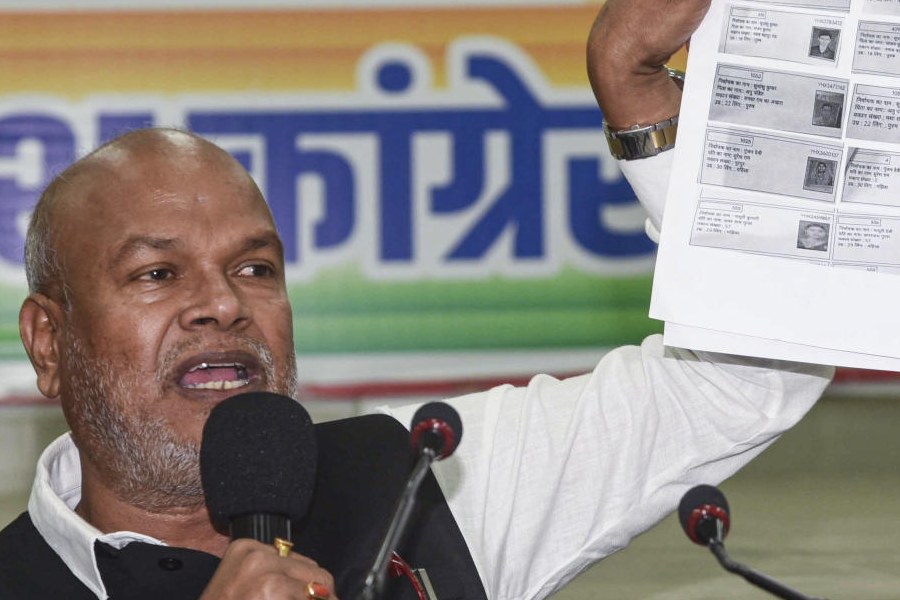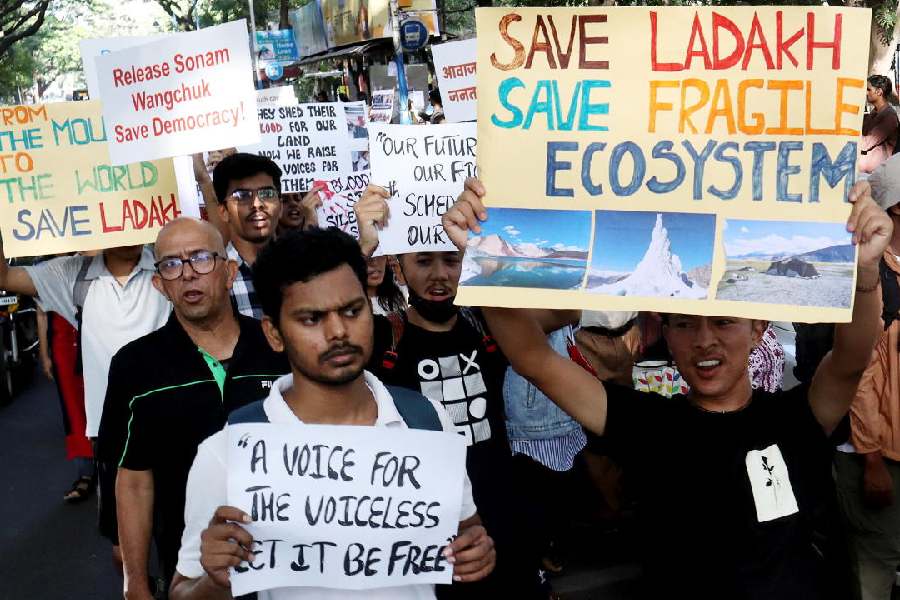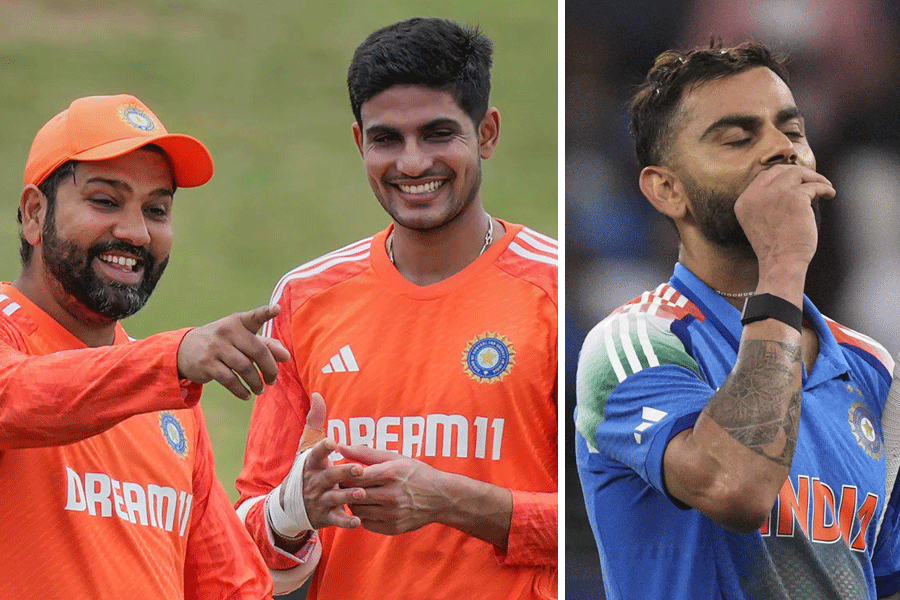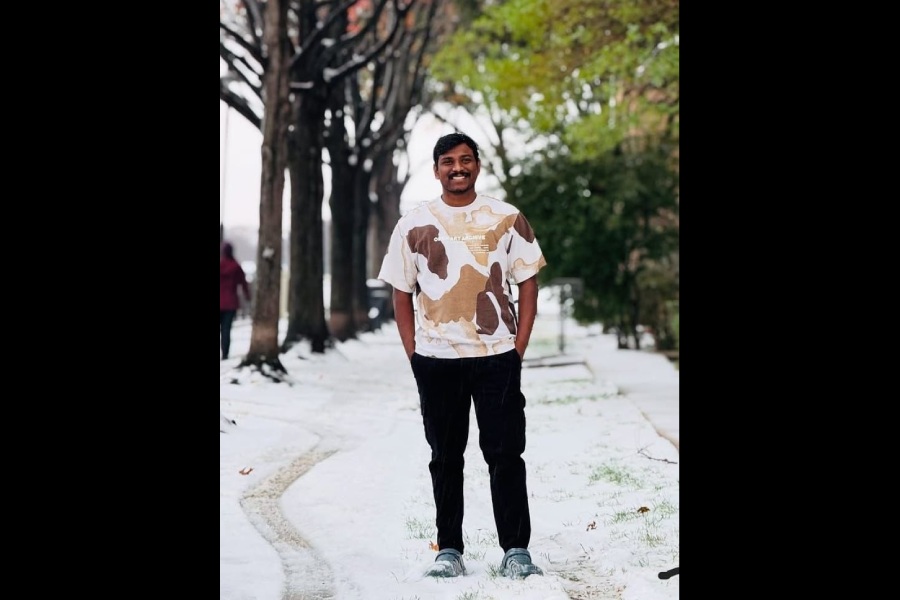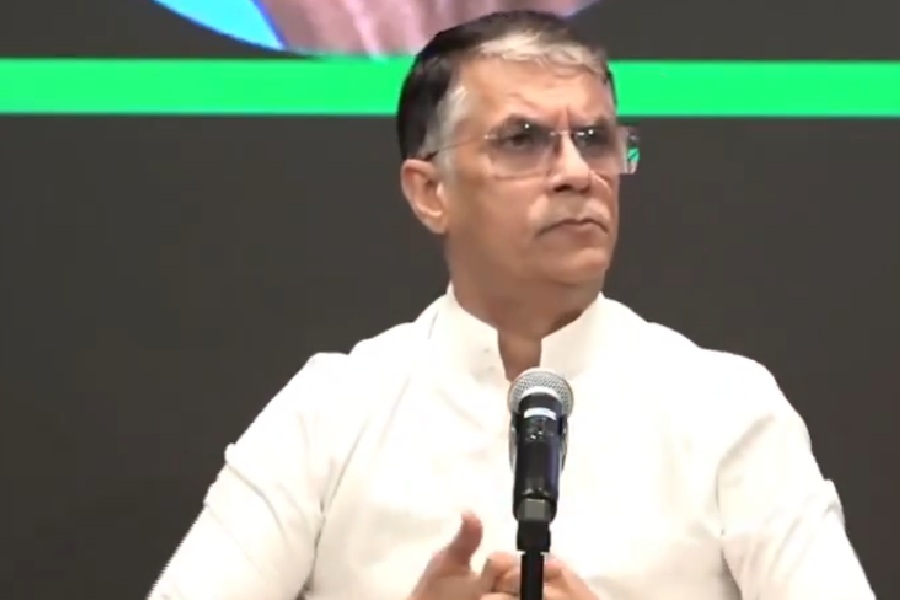 |
| Pic by Subhendu Chaki |
When fashion designer Sharbari Datta hosts her next fashion show, tuxedos with kantha work and block-printed suit jackets embellished with more kantha embroidery will rock the ramp. The male peacock is in for some surprises as Datta unveils her debut line of Western wear, which she hints will rewrite some fashion rules.
Datta is no newbie to making tradition stand on its head. Back in the early ’90s she wowed men by making dhoti-kurtas the stuff of high fashion. She threw caution to the winds and infused a huge spectrum of colours into men’s wardrobes and even emblazoned them with colourful motifs that ranged from Egyptian hieroglyphics to Calcutta’s landscape. Suddenly, bright dhotis, embroidered kurtas, and ornate angrakhas became the rage.
Now, as her signature label, Sharbari, turns 20 and is re-branded Sharbari Since 1991, she’s poised to take it to another level — she’s about to unveil her newest collection for men. She says: “I love Western formalwear. It can be smart and elegant. But I feel that it has never really evolved much in India so I decided to play around with it.” Datta has not touched the silhouettes but has played with embellishments. The line starts at Rs 50,000 (for a tuxedo).
 |
| Datta gives a handwoven tissue dhoti a cool makeover, pairing it with a printed tussar shirt and draping it like a sarong |
Datta has been conspicuous by her absence at almost every Indian fashion week that’s come pirouetting along over the past decade. She’s usually missing at air-kissing, Page 3 bashes that are so loved by the fashion fraternity. Says the 60-something, self- effacing fashion designer: “I simply refuse to be a part of the rat race. It’s not my comfort zone and I just don’t fit in there. I have never cared about selling at these events or for earning fame. I am content with what I have.”
Yet, she’s a much sought after designer, with a glittering A-list clientele (Sachin Tendulkar, Rahul Dravid, Vijay Mallya and the Bachchans are fans), who’s found herself a prime slot in the hierarchy of Indian menswear. So, perhaps it’s not surprising that she has National Award winning director Aniruddha Roy Chowdhury (of Antaheen fame) making a docu-feature about her while a coffee table book on the designer by art critic Ratnottama Sengupta is in the making to be published next year. The film will be screened at an upcoming show to celebrate her 20-years’ journey and to launch her Western wear line.
Datta also designed costumes for two films — Rituparno Ghosh’s Chokher Bali, based on Rabindranath Tagore’s novel of the same name, and Ghosh’s Antarmahal that was set in 19th century Bengal.
Says designer Abhishek Dutta: “Sharbari Datta’s creations represent Bengal and its craft on the national fashion scene. She creates apparel that will stand the test of time.”
Sunil Sethi, president Fashion Design Council of India (FDCI), agrees: “Menswear is a very specialised fashion segment and very few are qualified to be a part of it. Sharbari Datta is one of the few designers who’ve been successfully designing for men. But we’d love to see more of her in cities like Delhi and other parts of India than we do now.”
The key to success
 |
| Every garment that leaves her factory is hand-drawn by Datta, and then embroidered on by her workers (below). Pic: subhendu chaki |
 |
Datta calls herself a revivalist rather than a designer and has been a major force in giving kantha embroidery a new spin. A recent collection for an IPL post-match show saw kantha make a splash on beach wear as sherwanis teamed with kantha-embroidered hot pants. “The audiences loved it and the show was a hit. Even Vijaya Mallya bought a few pieces,” says choreographer Prasad Bidappa, who worked with her on the show.
And then there’s her penchant for colours. Her brand, she says, is a celebration of the Indian man’s right to as rich and vibrant a wardrobe as his female counterpart. So, her colour palette is a rainbow of colours — red, purple, blue, magenta, yellow, green.
The stripes/checks and greys and blues that were favoured at the time she stepped into this glamorous world of fashion, she says, were after all a colonial hangover. “Traditionally, in India, like in Chinese, Japanese, African and all indigenous cultures, men wore bright colourful clothes with brilliant designs and patterns,” Datta points out. Colours had no gender. “I just succeeded in reviving that,” she says. “My work is popular because I have successfully contemporarised our rich tradition.”
And while her fabrics range from silks to tussar and tissue to linen, embellishments include silver, gold-plated silver, brass, copper, semi-precious stones and even Swarovski crystals. Her traditional wear starts at around Rs 9,000 and can go up to Rs 2.25 lakh for a sherwani-churidar ensemble.
Says film-maker Rituparno Ghosh: “There have been inferior clones of Sharbari’s work but her originality and innovation comes from her rich literary and cultural background. That’s not easy to clone.”
The daughter of celebrated post-Tagorean poet Ajit Datta, the designer grew up in a household where steaming cups of tea fuelled literary debates and philosophical discussions every evening. Books, music, art, theatre, cinema were as much a part of her growing up as much as dolls and dresses.
Datta never studied art though. “I feel connected to rural or tribal artists, who are not formally trained and work instinctively,” says Datta. Even now the designer draws free hand on every single garment that she sells. Her only equipment — “two kinds of pencils and a scale. Sometimes, an eraser.”
Also Datta, like rural artisans, draws her inspiration from nature and things around her. She says that what she additionally brings to the table is the fact that she is armed with the knowledge of world art traditions. “Apart from indigenous styles like Warli, Pat and Madhubani, I’m aware of the styles of masters like Pablo Picasso or MF Husain and world art forms like Aztec art, African folk art, Chinese art, and I can use this knowledge in my work,” she says.
So, Datta’s collections often flaunt motifs from ancient Mohenjodaro-style drawings and Egyptian hieroglyphics to urban landscapes. No wonder then that Datta gets most excited when artists buy her works. “Whenever masters like MF Husain, Paresh Maity, Manjit Bawa and Bikash Bhattacharjee have appreciated and worn my creations, it felt like being awarded a certificate. It’s like a blessing.”
 |
| From Tollywood stars like Dev (above left) and Tota Roy Chowdhury to cricket legends like Sunil Gavaskar (below), Sharbari’s creations have always attracted celebrity attention. Pic: Bishwarup Dutta |
 |
A latecomer on the fashion scene — Datta was over 40 when she began designing — she says that it was the profession that chose her rather than the other way around. Datta started her journey in 1991 with an exhibition-cum-sale of her works. “Till then, I was basically a housewife looking after my family, entertaining guests and the like,” she says.
“I used to draw patterns on the garments of my family members and then have them embroidered by local seamstresses. My friends and family loved my work and egged me on to do an exhibition,” she recalls. “I was low on confidence and clueless about the commercial viability of the line. I didn’t even know how to publicise the collection,” she recalls.
Despite her misgivings, the show was a sell-out. Everything except — ironically — her coloured dhotis (that are the rage today) flew off the racks.
There was no looking back after that. And the journey so far has been a smooth one. “Luckily for me it was a case of Veni, vidi, vici,” she laughs.
She started work with eight to 10 artisans. Today, Datta’s production unit operates from a three-storeyed building in the city’s Kasba Industrial Estate. She has a 50-strong workforce that includes tailors and embroiderers, who do a whole range of work like kantha, ari and zardozi. Most of them have been with her for over 10 years and are so well-acquainted with her style of work that even instructions from the designer over the phone suffice at times.
Datta will felicitate her oldest workers at her upcoming show. “I’d be nowhere without my workers,” says Datta, who retails only from home. “Selling from home not only ensures exclusivity but also allows us to build a personal bond with the clients. It’s not just a business transaction for us, it’s getting to know people,’’ says Datta’s son, Amalin. “We only send some pieces to Aza in Mumbai during the wedding season,” adds Kanaklata, Datta’s daughter-in-law, who handles production.
When she’s not poring over her garments, pencil in hand, Datta likes to listen to music, cook, read or tend to her plants. Her day starts with a cup of tea at 5.30am in her garden, which is followed by a Yoga session. She then gets down to household chores. Datta insists that her home has never taken a back seat despite her growing volume of work. “I have no fixed time slot for designing. I work whenever I feel like,” she says. Her workplace is just an old wooden desk in her bedroom.
Does designing for women feature in her future plans? “Not just yet. I’m too busy with my menswear lines. Besides, I don’t feel like it yet. I want to keep doing things on my terms and according to my comfort,” she says.
Which is why, she says, she has no long-term plans. “I prefer living each day as it comes. There’s no use planning. I was an ordinary housewife, in my 40s when I set foot in this field — and all this happened. It’s destiny,” she says contentedly.


